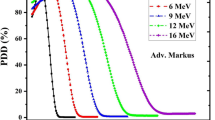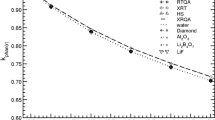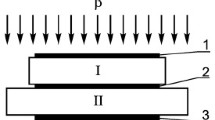Background:
Depth dose curves and lateral dose profiles should correspond to relative dose to water in any measured point, what can be more or less satisfied with different detectors. Diamond as detector material has similar dosimetric properties like water. Silicon diodes and ionization chambers are also commonly used to acquire dose profiles.
Material and Methods:
The authors compared dose profiles measured in an MP3 water phantom with a diamond detector 60003, unshielded and shielded silicon diodes 60008 and 60012 and a 0.125-cm3 thimble chamber 233642 (PTW, Freiburg, Germany) for 6- and 25-MV photons. Electron beams of 6, 12 and 18 MeV were investigated with the diamond detector, the unshielded diode and a Markus chamber 23343.
Results:
The unshielded diode revealed relative dose differences at the water surface below +10% for 6-MV and +4% for 25-MV photons compared to the diamond data. These values decreased to less than 1% within the first millimeters of water depth. The shielded diode was only required to obtain correct data of the fall-off zones for photon beams larger than 10 × 10 cm2 because of important contributions of low-energy scattered photons. For electron radiation the largest relative dose difference of –2% was observed with the unshielded silicon diode for 6 MeV within the build-up zone. Spatial resolutions were always best with the small voluminous silicon diodes.
Conclusion:
Relative dose profiles obtained with the two silicon diodes have the same degree of accuracy as with the diamond detector.
Hintergrund:
Tiefendosiskurven und Dosisquerprofile sollten in allen Messpunkten der relativen Wasserenergiedosis entsprechen, was mit verschiedenen Messsonden mehr oder weniger gut erreicht wird. Diamantsonden verhalten sich dosimetrisch fast wasseräquivalent. P-Typ-Siliciumdioden und Ionisationskammern werden ebenfalls häufig zur Messung von Dosisprofilen genutzt.
Material und Methodik:
In einem MP3-Wasserphantom wurden gemessene Tiefendosiskurven und Dosisquerprofile einer Diamantsonde 60003, je einer ungekapselten und einer gekapselten Si-Diode 60012 und 60008 und einer 0,125-cm3-Schlauchkammer 233642 (alle von PTW, Freiburg) für 6- und 25-MV-Photonenstrahlung verglichen. Elektronenfelder (6, 12 und 18 MeV) wurden mit der Diamantsonde, der ungekapselten Diode und einer Markus-Kammer 23343 untersucht.
Ergebnisse:
Bei Photonenstrahlung konnte für die ungekapselte Diode an der Wasseroberfläche eine Abweichung der relativen Tiefendosis im Vergleich zur Diamantsonde kleiner +10% bei 6 MV und kleiner +4% bei 25 MV festgestellt werden. Diese Abweichungen sanken bereits in einigen Millimetern Wassertiefe auf unter 1% ab. Die gekapselte Diode war ausschließlich für die korrekte Messung der abfallenden Bereiche von Tiefendosiskurven bei Feldern über 10 × 10 cm2 erforderlich, da die hier hohen Beiträge der niederenergetischen Streustrahlungsphotonen von Silicium überproportional stark absorbiert und registriert werden. Die maximal gemessene Abweichung der relativen Tiefendosis mit der ungekapselten Diode bei Elektronenstrahlung betrug –2% innerhalb der Aufbauzone bei 6 MeV. Bei allen untersuchten Strahlenarten übertraf das räumliche Auflösungsvermögen der kleinvolumigen Dioden das der Diamantsonde.
Schlussfolgerung:
Mit den beiden Dioden gemessene relative Dosisprofile sind vergleichbar genau wie die mit der Diamantsonde gemessenen.
Similar content being viewed by others
References
Bogner L, Scherer J, Treutwein M, et al. Verification of IMRT: techniques and problems. Strahlenther Onkol 2004;180:340–50.
Bucciolini M, Banci Buonamici F, Mazzocchi S, et al. Diamond detector versus silicon diode and ion chamber in photon beams of different energy and field size. Med Phys 2003;30:2149–54.
Das IJ, Cheng CW, Watts RJ, et al. Accelerator beam data commissioning equipment and procedures: report of the TG-106 of the Therapy Physics Committee of the AAPM. Med Phys 2008;35:4186–215.
DIN 6800-2. Dosismeßverfahren nach der Sondenmethode für Photonenund Elektronenstrahlung. Teil 2: Ionisationsdosimetrie. Berlin: Beuth, 1997.
Ding GX, Cygler JE, Yu CW, et al. A comparison of electron beam dose calculation accuracy between treatment planning systems using either a pencil beam or a Monte Carlo algorithm. Int J Radiat Oncol Biol Phys 2005;63:622–33.
Djouguela A, Grießbach I, Harder D, et al. Dosimetric characteristics of an unshielded p-type Si diode: linearity, photon energy dependence and spatial resolution. Z Med Phys 2008;18:301–6.
Förster U, Pfaender M, Grebe G. Eigenschaften eines kommerziellen Hi-pSi-Detektors für die Dosimetrie stereotaktischer Kollimatoren mit sehr kleinen Durchmessern. Strahlenther Onkol 2002;179:343–7.
Griessbach I, Lapp M, Bohsung J, et al. Dosimetric characteristics of a new unshielded silicon diode and its application in clinical photon and electron beams. Med Phys 2005;32:3750–4.
Hoban PW, Heydarian M, Beckham WA, et al. Dose rate dependance of a PTW diamond detector in the dosimetry of a 6 MV photon beam. Phys Med Biol 1994;39:1212–29.
Laub WU, Kaulich TW, Nüsslin F. A diamond detector in the dosimetry of high-energy electron and photon beams. Phys Med Biol 1999;44:2183–92.
Li J, Doemer A, Harrison AS, et al. Dose calculation using Monte Carlo algorithm of Monaco treatment planning system. Int J Radiat Oncol Biol Phys 2008;72:Suppl 1:S674.
Mika S, Christ G. Experimentelle Validierung eines Monte-Carlo-basierten Bestrahlungsplanungssystems für Elektronenstrahlung. Strahlenther Onkol 2007;183:150–6.
Pittomvils G, Coghe M, De Gersem W, et al. Measurement techniques, modeling strategies and pitfalls to avoid when implementing a mini MLC in a non dedicated planning system. Strahlenther Onkol 2007;183:637–44.
Ramm U, Licher J, Moog J, et al. In vivo dosimetry with semiconducting diodes for dose verification in total-body irradiation. Strahlenther Onkol 2008;184:376–80.
Rikner G, Grusell E. General specifications for silicon semiconductors for use in radiation dosimetry. Phys Med Biol 1987;32:1109–17.
Roth J. Ergebnisse von Qualitätskontrollen der individuellen Patientendosen in der Radioonkologie. Strahlenther Onkol 2008;184:505–9.
Saini AS, Zhu TC. Temperature dependence of commercially available diode detectors. Med Phys 2002;29:622–30.
Saini AS, Zhu TC. Dose rate and SDD dependence of commercially available diode detectors. Med Phys 2004;31:914–24.
Sánchez-Doblado F, Hartmann GH, Pena J, et al. Uncertainty estimation in intensity-modulated radiotherapy absolute dosimetry verification. Int J Radiat Oncol Biol Phys 2007;68:301–10.
Scherf C, Scherer J, Bogner L. Verifikation und Anwendungen des voxelbasierten Monte-Carlo-(VMC++−)Elektronen-Dosismoduls von Oncentra™ MasterPlan. Strahlenther Onkol 2007;183:81–8.
Schwedas M, Scheithauer M, Wiezorek T, et al. Strahlenphysikalische Einflussgrößen bei der Dosimetrie mit verschiedenen Detektortypen. Z Med Phys 2007;17:172–9.
Song H, Ahmad M, Deng J, et al. Limitations of silicon diodes for clinical electron dosimetry. Radiat Prot Dosim 2006;120:56–9.
Treutwein M, Bogner L. Elektronenfelder in der klinischen Anwendung. Ein Vergleich von Pencil-Beam- und Monte-Carlo-Algorithmus, Strahlenther Onkol 2007;183:454–8.
TRS IAEA. Absorbed dose determination in external beam radiotherapy. Technical report 398. Vienna: International Atomic Energy Agency, 2000:41–2.
Wang LLW, Rogers DWO. Monte Carlo study of Si diode response in electron beams. Med Phys 2007;34:1734–42.
Zhu TC, Das IJ, Bjärngard BE. Characteristics of bremsstrahlung in electron beams. Med Phys 2001;28:1352–8.
Author information
Authors and Affiliations
Corresponding author
Rights and permissions
About this article
Cite this article
Scherf, C., Peter, C., Moog, J. et al. Silicon Diodes as an Alternative to Diamond Detectors for Depth Dose Curves and Profile Measurements of Photon and Electron Radiation. Strahlenther Onkol 185, 530–536 (2009). https://doi.org/10.1007/s00066-009-2004-x
Received:
Accepted:
Published:
Issue Date:
DOI: https://doi.org/10.1007/s00066-009-2004-x




